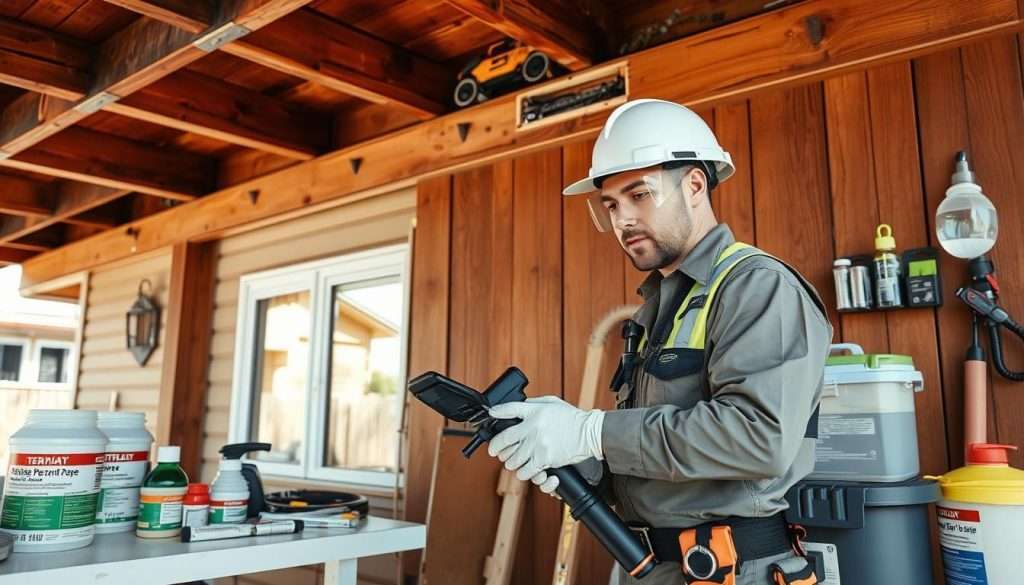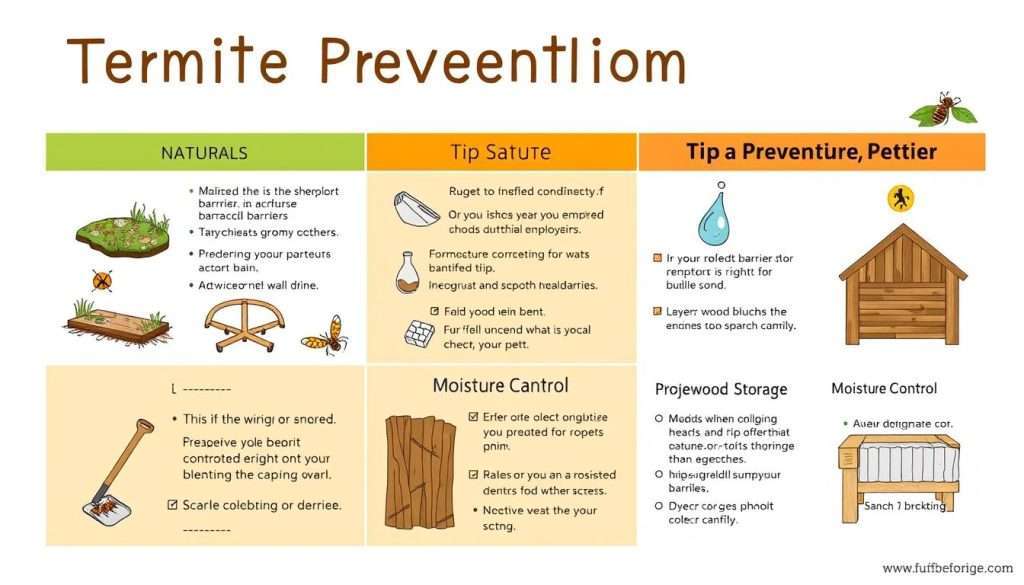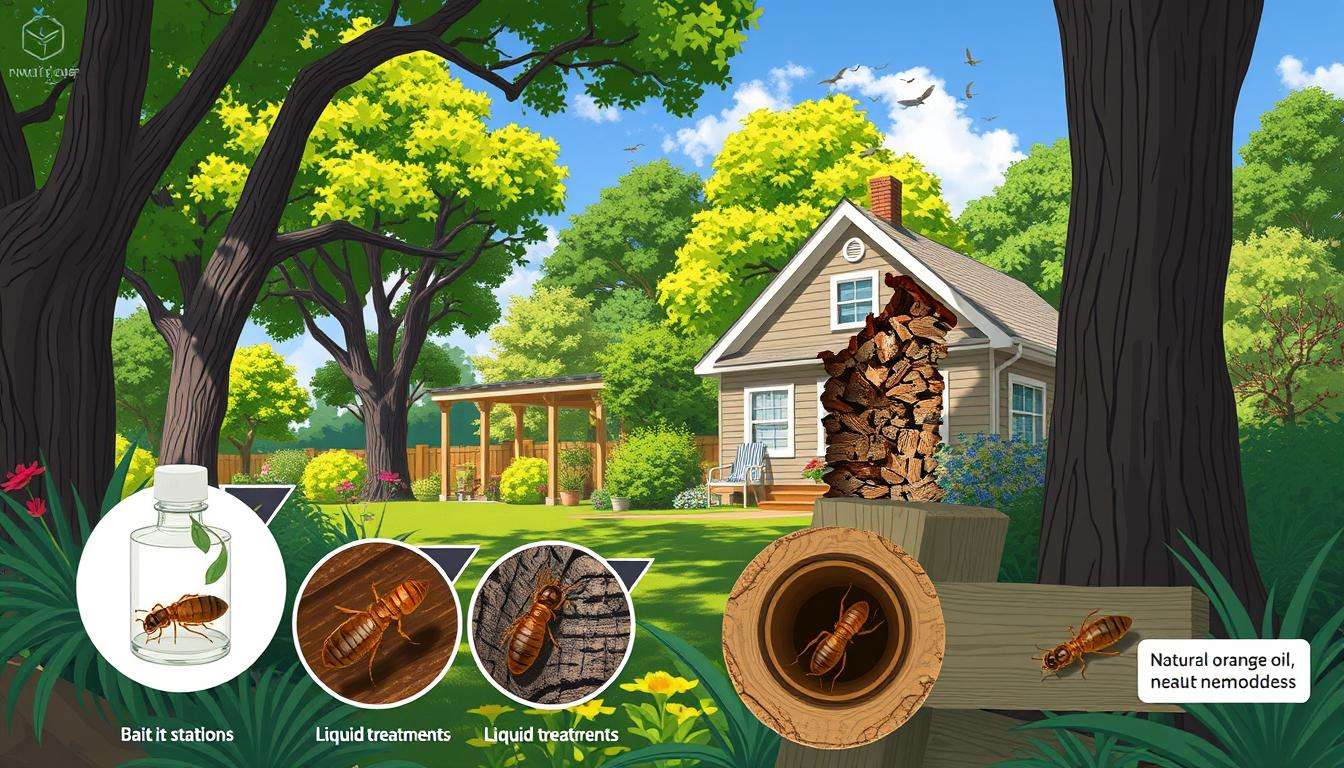Welcome to our guide on getting rid of termites. Termites cause about $30 billion in damage in the U.S. each year. It’s important to know about these pests and how to stop them.
We’ll teach you about termite control methods. You’ll learn how to spot an infestation and what to do about it. We’ll cover DIY and professional options to protect your home.
This guide will help you understand termites and their dangers. We’ll talk about how to prevent damage and fix it if it happens. If you’re dealing with termites or want to prevent them, this guide is for you. For more info, check out our resources here.
Key Takeaways
- Termites can cause significant damage, so early detection is crucial.
- Identifying the type of termite is essential for effective treatment.
- Regular inspections by professionals can prevent future infestations.
- Effective chemical treatments can last 5-10 years, providing long-term protection.
- DIY solutions may not ensure complete removal; professional help is advisable.
Understanding Termites and Their Impact
Termites are important in our ecosystem. They help break down dead wood and recycle nutrients. But, they are also known for damaging homes. Knowing about termites and their behavior helps homeowners prevent infestations and reduce risks.
What Are Termites?
Termites are social insects that live in colonies. They eat cellulose in wood, which is a big worry for homeowners. A termite colony has workers, soldiers, and reproductive members. Each one has a special role in the colony’s survival.
Types of Termites: Drywood vs. Subterranean
There are many types of termites, but the main two are:
- Drywood Termites: These termites live in dry wood, like attic framing. A sign of drywood termites is their fecal pellets.
- Subterranean Termites: These are the most common. They live underground and can cause a lot of damage. Look for mud tubes from the soil to the wood to spot them.
Signs of Termite Infestation
Spotting termite infestations early is key to less damage. Look out for:
- Mud tubes on walls or foundations.
- Discarded wings near windows or doors.
- Wood that sounds hollow when tapped.
Being alert to these signs helps homeowners take action fast. This can save a lot of money on repairs.
How to Identify Termites
Spotting termites early is key to avoiding big damage. Knowing how termites look different from ants helps a lot. Once you can spot termites, finding signs of a problem gets easier.
Visual Differences Between Termites and Ants
To tell termites from ants, look at these points:
- Body shape: Termites are thicker with no waist, ants have a narrow waist.
- Wings: Termites have two pairs of wings the same length. Ants have wings of different lengths.
- Color: Termites are usually lighter, ants are darker.
These differences help you spot termites faster and more easily.
Common Signs of a Termite Problem
Here are signs you might have termites:
- Swarmers: Winged termites show up in spring or fall, meaning there’s a colony nearby.
- Wing piles: Small wing piles near windows or foundations mean termites are swarming.
- Frass: Tiny fecal mounds, or frass, near infested wood are signs of drywood termites.
- Mud tubes: Subterranean termites make mud tubes to travel to wood. These tubes are a sign of their presence.
- Tapping sounds: A hollow sound when tapping on wood means termites might be inside.
Spotting these signs early lets you act fast and protect your home from termites.
How to Get Rid of Termites
Dealing with termites can seem tough, but there are good ways to handle it. You might want to try DIY methods or look into professional treatments. Knowing your options is key to getting rid of termites.
DIY Termite Removal Techniques
If you have a small termite problem, DIY methods can work. Here are some natural products that can fight termites:
- Boric Acid: Stops termites from getting nutrients and can be used straight or mixed with water.
- Nematodes: These tiny worms kill termites without harming people or pets.
- Orange Oil: Has D-limonene that kills termites early and stops them from reproducing.
- Neem Oil: Changes termite hormones to stop them from making babies and smells bad to them.
- Cardboard Bait Systems: Use moist cardboard to attract termites, then throw it away when it’s full.
- Diatomaceous Earth: A natural powder that kills termites when they touch it.
- Salt and Cayenne Pepper: Mix these to repel or kill termites.
These DIY methods can work well. But, if you see a lot of termites, you might need something stronger.
Choosing the Right Termite Treatment Options
Thinking about how to get rid of termites? Professional pest control might be a good idea. They have the tools and know-how to handle big problems. They use different methods based on the type of termite and how bad the problem is. Some common methods include:
| Treatment Method | Description |
|---|---|
| Soil Treatments | Use rods to apply liquid treatments in the soil to stop subterranean termites. |
| Gas Fumigation | Seals the house and uses special gases to kill drywood termites. |
| Bait Stations | Attract and kill termites with bait stations placed around the property. |
| Direct Wood Treatment | Uses insecticides directly on wooden structures to kill termites. |
Always follow the instructions on the product label and be careful when using any treatment. Keeping an eye on things and preventing termites is important for keeping them away for good.
Professional Termite Services
Knowing the benefits of professional termite services is key for homeowners. Many wonder when to call a pest control expert and what to expect. Getting help early is vital for managing termites well.
When to Call a Pest Control Expert
Knowing when to call for help is important. Look for these signs:
- Visible signs of termite damage, such as hollowed wood or mud tubes.
- Unexplained noises within walls, indicating active colonies.
- Seasonal swarming near windows or doors.
- History of termite issues in the area.
Acting fast can stop big damage. It keeps your home safe from termites.
What to Expect from Professional Treatments
Here’s what happens when you get professional help:
- Comprehensive Inspection: Experts will check your home inside and out for termites.
- Treatment Plan Development: They’ll make a plan based on what they find, targeting the termites.
- Application of Treatments: They might use baiting systems, localized treatments, or fumigation.
- Post-Treatment Follow-Up: They’ll check if the treatment worked and suggest how to prevent future problems.
Working with pest control experts is safe. They use low-concentration pesticides and manage pests well.

| Factor | Details |
|---|---|
| Experience of Company | Companies like Orkin have over 90 years of termite control experience, showing their skill. |
| Cost Variability | Costs change based on how big the problem is, the treatment, and your property. |
| Inspection Importance | Good inspections find hidden damage and help choose the right treatment. |
| Preventative Measures | After treatment, it’s important to take steps to avoid termites in the future. |
Termite Control Methods
Managing termites requires a mix of solutions. Homeowners can use both chemical and non-chemical methods. This helps protect their homes from these pests.
Effective Chemical Treatments
Chemical treatments are a common first step against termites. They use Fipronil and Imidicloprid to create a barrier. This barrier stops termites from getting inside.
Termite baits, like the Trelona ATBS Termite Bait System, also help. They contain slow-acting termiticide. This lets termites carry the bait back to their nests, slowly killing them.
- Liquid Treatments: Applied by digging a trench around the home, these treatments can last up to five years.
- Wood Treatments: Surface sprays or injections penetrate and protect timber, especially during construction.
- Fumigation: For severe infestations, fumigation using sulfuryl fluoride can be the most effective approach, often required for drywood termites.
Non-Chemical Approaches to Termite Control
For those who prefer not to use chemicals, there are other options. These methods focus on making your home less appealing to termites. Key non-chemical approaches include:
- Moisture Control: Reducing humidity levels around your home can significantly deter termites, as they thrive in moist environments.
- Sand Barriers: Implementing sand barriers around the foundation prevents subterranean termites from accessing the property.
- Regular Maintenance: Conduct routine inspections of areas like sills, subfloors, and support posts to catch infestations early and prevent extensive damage.
By using both chemical and non-chemical methods, homeowners can create a strong plan. This helps them tackle termite problems effectively.
Termite Prevention Tips
To keep your home safe from termites, you need to act early. Using termite prevention tips can help avoid the trouble and cost of an infestation. Keeping your home clean and well-maintained is key to stopping termites.
Creating a Barrier Against Termites
Setting up barriers can protect your home from termites. Here are some ways to do it:
- Keep wooden structures at least six inches off the ground to reduce contact with soil.
- Seal any cracks or gaps in wood to stop drywood termites from getting in.
- Make sure weep holes are at least 75mm above ground to keep termites out.
- Don’t plant garden beds too close to your house walls to avoid attracting termites.
- Choose termite-resistant mulch to keep your garden safe from termites.
Home Maintenance Strategies for Prevention
Good home maintenance strategies can help prevent termites.
- Remove dead trees, firewood, and rotting wood from around your house.
- Check your plumbing for leaks, as moisture can attract termites.
- Get annual checks from pest control experts to catch problems early.
- Make sure your house is built right, with enough space between wood and ground.
- Be careful with spa baths, as they can attract termites if not built correctly.
By following these tips, you can protect your home from termites and keep it healthy.

| Strategy | Description | Benefit |
|---|---|---|
| Wood-to-Ground Clearance | Maintain at least six inches between wood and soil. | Reduces direct access for termites. |
| Seal Cracks | Fill gaps in exterior wood structures. | Prevents entry of drywood termites. |
| Weep Hole Maintenance | Ensure weep holes are clear and elevated. | Discourages moisture accumulation. |
| Moisture Control | Fix leaks and manage water around the home. | Minimizes attraction to termites. |
| Dead Wood Removal | Eliminate dead trees and firewood from property. | Reduces nesting sites for termites. |
Termite Damage Repair
Termite infestations can cause a lot of damage to a home. Often, people don’t even notice it until it’s too late. It’s important to know how to check and fix infested wood to protect your home. We’ll show you how to assess infested wood and find long-term solutions for fixing it.
Assessing and Repairing Infested Wood
First, you need to see how bad the termite damage is. Use tools like screwdrivers or ice picks to find soft spots and trails. Check areas like:
- Sills
- Floor joists
- Subfloors
- Wall studs
- Ceiling and roof structures
If the damage is small, you might just need to fix the look. Use wood filler or putty to cover up tunnels. But if the damage is big, you’ll need to do more. This can include:
- Replacing damaged beams
- Injecting foam into smaller wood sections
- Getting professional carpenters for big repairs
Long-Term Solutions to Repair Termite Damage
For long-term fixes, you want to stop termites from coming back and keep your home strong. Here are some ideas:
- Get regular checks from experts to catch problems early.
- Use treatments like Termidor to kill termites or Sentricon to stop them from coming back.
- Seal up cracks and openings in your foundation to keep termites out.
Working with a skilled contractor is key for good termite damage repair. They can make sure the job is done right and lasts. Remember, fixing termite damage can cost between $250 and $40,000. Getting quotes from different contractors can help you find the best deal.
Conclusion
We’ve looked at how to get rid of termites in this guide. We talked about understanding these pests and how to spot and manage infestations. It’s important to catch termite problems early to avoid big damage.
Each type of termite, like subterranean, drywood, and dampwood, needs a different approach. This is because they each have their own challenges.
Preventing termites is also key. Keeping your home and wooden parts in good shape helps a lot. Using DIY methods and getting help when needed is a good plan.
Being alert and knowing how to spot threats is crucial. This way, you can act fast and protect your home. With the right steps and knowledge, you can keep termites away and feel safe.
